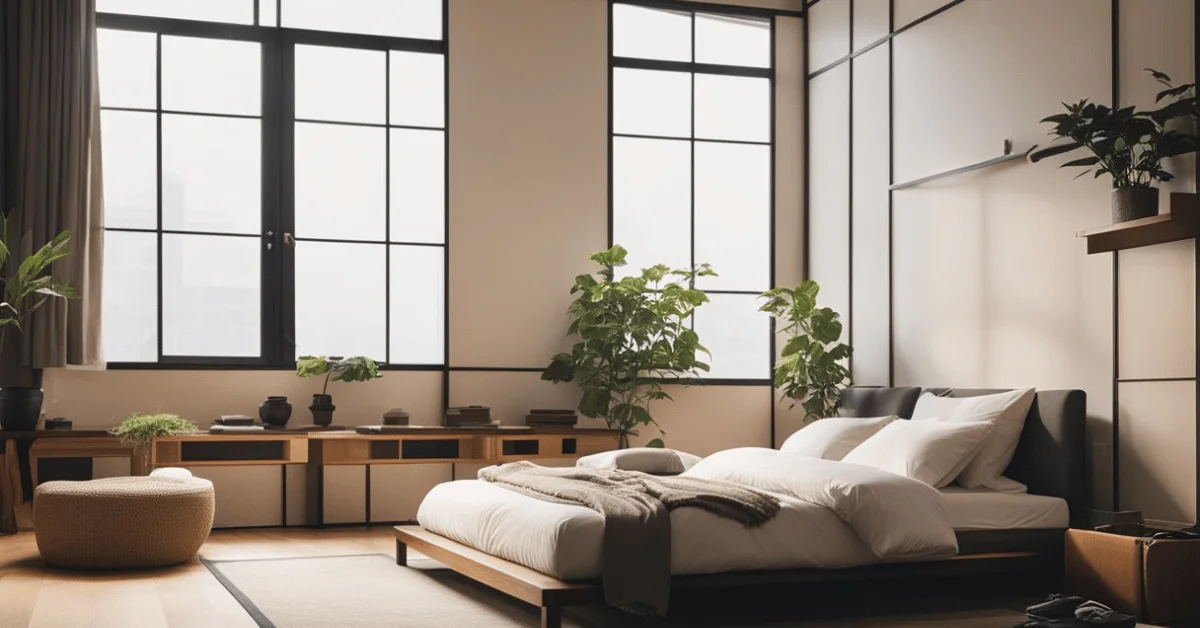The Japanese minimalist bedroom embodies a design ethos grounded in the principles of simplicity, natural beauty, and functional elegance, reflecting a deep-rooted aspect of Japanese culture.
These spaces are often characterized by their clean lines and a lack of clutter, which work together to create a tranquil and harmonious environment. The aesthetic draws from the traditional Japanese Zen philosophy, which emphasizes the importance of mindfulness and the value of embracing less to enjoy a more meaningful existence.
In crafting such a bedroom, every element serves a purpose and is carefully chosen to support a serene living space. Furnishings are typically low to the ground and multifunctional, honoring the minimalist approach while also respecting the spatial constraints often found in Japanese homes. The color palette leans towards muted, earthy tones, complementing the natural materials like wood and bamboo frequently used in furniture and decor.
This strategic selection aids in cultivating a space that feels open, light, and peaceful, conducive to rest and relaxation.
Key Takeaways
- Emphasizes simplicity and mindfulness in design.
- Chooses multifunctional furniture to create harmony and save space.
- Utilizes muted colors and natural materials for a calming atmosphere.
Design Principles of Minimal Japanese Bedrooms
In creating a minimal Japanese bedroom, we focus on crafting serene environments that offer tranquility and balance. By adhering to design principles that emphasize simplicity and natural beauty, we can create spaces that are both functional and calming.
Embracing ‘Ma’ and Space
‘Ma’ represents the philosophical concept of negative space—valuing the empty space between objects just as much as the objects themselves. We ensure that rooms have ample space, promoting a more expansive and tranquil atmosphere. This principle supports balance and harmony within the bedroom.
Natural Materials and Colors
We prioritize the use of natural materials such as wood, bamboo, and rice straw for furniture and flooring, which evoke a connection to nature. The color palette leans towards earthy and neutral colors, reflecting the natural beauty found outdoors and enhancing the sense of calm.
Clutter-Free Philosophy
Minimalist bedrooms thrive on being uncluttered and decluttered, which promotes a relaxing and orderly space. Every item in a minimal Japanese bedroom serves a purpose or brings joy, contributing to a clutter-free and serene environment.
Incorporating Traditional Elements
Elements such as tatami mats, futons, and shoji screens are incorporated to preserve the authentic Japanese aesthetic. These traditional items are not only rooted in Japanese culture but also embody the principles of minimalism with their simplicity and functionality.
Modern Adaptations
While honoring traditional designs, a modern minimal Japanese bedroom can blend contemporary elements. The Japandi style, a union of Japanese and Scandinavian aesthetics, uses geometric shapes and a blend of modern with rustic elements, maintaining functionality and a minimalist approach.
Functional Simplicity
Every piece of minimalist furniture is selected for its functionality and simple design. Storage solutions are often built-in or concealed to maintain the sleek, uncluttered appearance of the space. The functionality of simple, minimalist furniture maximizes comfort without sacrificing style or space.
Importance of Harmony and Contrast
Finally, we strike a balance between harmony and contrast. This is achieved through the subtle play of light and dark, rough and smooth textures, and the juxtaposition of different natural materials. By thoughtfully curating items and features that juxtapose yet complement each other, we create bedrooms that are intrinsically balanced and aesthetically pleasing.
Furniture and Layout
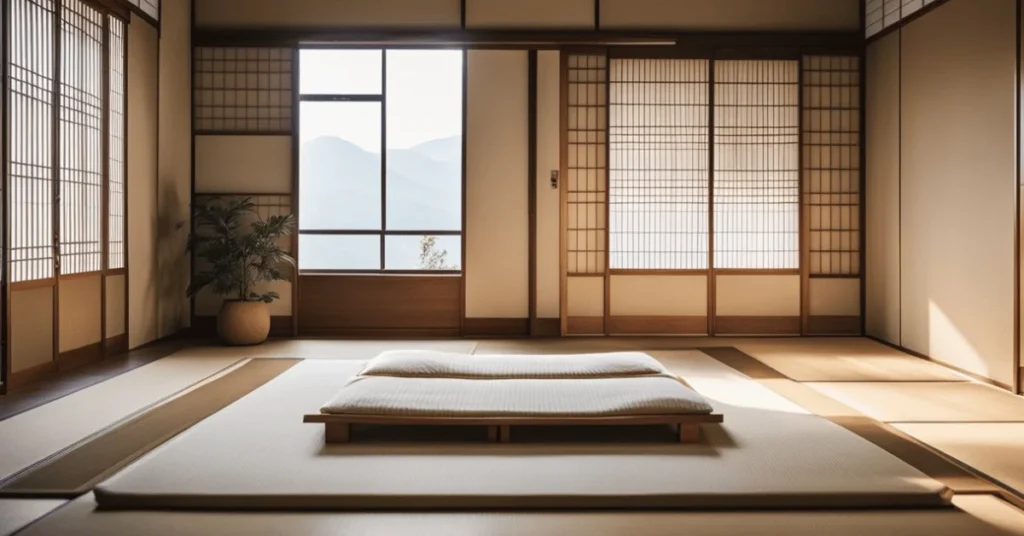
In crafting a minimal Japanese bedroom, we focus on functionality and simplicity, ensuring that every piece of furniture has a purpose and contributes to the serene atmosphere of the space.
Essential Bedroom Furniture
In our minimal bedroom, we select furniture that embodies simplicity and elegance. A low-profile bed or futon placed on tatami flooring acts as the centerpiece. This not only adheres to traditional Japanese design but also promotes a grounded and calming sleep environment. We incorporate minimalist furniture like a sleek desk or chabudai, a low Japanese table, to maintain the uncluttered aesthetic.
- Bed/Futon: Low to the ground for simplicity and ease.
- Desk/Chabudai: Compact and functional to suit daily needs.
Efficient Use of Space
Space efficiency is paramount. We thoughtfully arrange furniture to create an airy and open room. Storage is often built-in or concealed, incorporating storage solutions under the bed or within multi-functional pieces. We also ensure that the placement of each item allows for free movement and harmonious flow throughout the room.
- Built-in Storage: Hidden compartments and under-bed drawers.
- Free Movement: Ample space between furniture items.
Bedding and Comfort
The comfort within our minimal bedroom is never compromised. We choose bedding that encourages restful sleep, using linen or other comfortable fabrics for our kakebuton (duvets) and makura (pillows). These elements are not only about comfort but also serve as subtle aesthetic complements to the minimalist design.
- Kakebuton: Soft, ensuring warmth and comfort.
- Makura: Ergonomic support for a restful night.
Multi-functional Pieces
Our minimalist approach includes furniture that can transform and serve multiple purposes, making it perfect for smaller spaces. Pieces like a kotatsu, a heated table that can be used for dining or as a workspace, or beds with integrated storage, exemplify our commitment to functionality within a minimal footprint.
- Kotatsu: Versatile through seasons, doubling as a heater.
- Storage Beds: Maximize space while retaining design purity.
Aesthetic Details and Decor
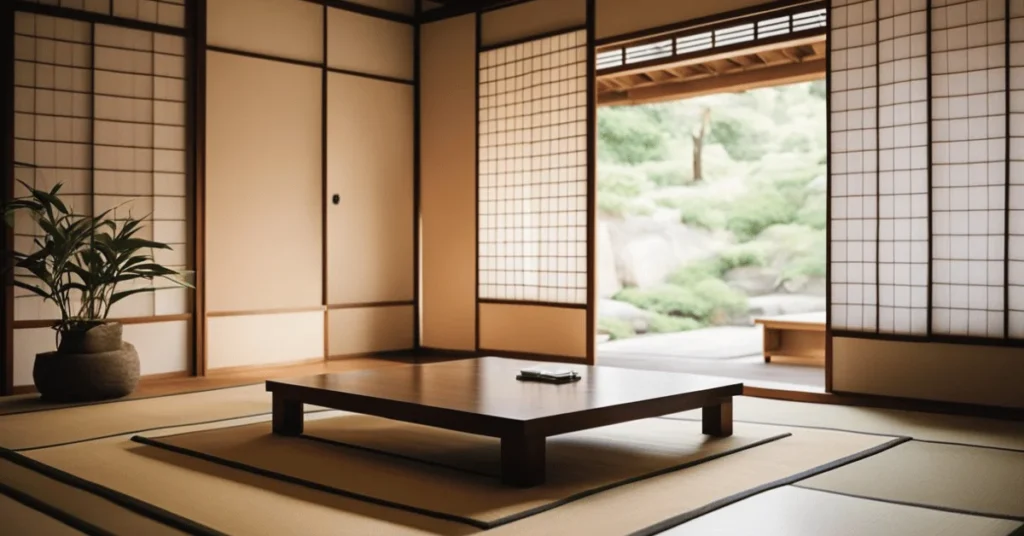
We understand that the essence of a minimal Japanese bedroom lies in its minimalist aesthetic, where every detail is both purposeful and serene, contributing to a sense of peace and tranquility.
Textiles and Linens
We choose textiles that embody comfort and simplicity. Our linens typically feature neutral colors such as whites, creams, and greys—these colors promote a calm and restful environment. The fabrics themselves are often natural, like cotton or linen, ensuring breathability and a pleasant tactile experience. We favor minimal patterns, which allows for a seamless blend of textiles into the serene decor.
- Comfort: Prioritizing soft and breathable materials.
- Color Palette: Focusing on neutral tones that do not overwhelm the senses.
Art and Culture
In our bedrooms, art is more than just decoration—it’s a reflection of Japanese culture. We might display a carefully selected painting that embodies Zen principles or hang a subtle photo reflecting natural scenes. Another key element is the use of byobu or folding screens, which often depict nature scenes or historical events in a gentle, subdued manner. These cultural artifacts infuse the space with a connection to Japanese tradition and aesthetics.
- Byobu: Adding a functional and cultural element to the space.
- Paintings/Photos: Chosen for their calmness and cultural resonance.
Light and Ambiance
A masterful control of lighting creates the distinctive ambiance of a minimal Japanese bedroom. Natural light is maximized during the day, while at night, lamps are placed strategically to create soft pools of light that do not overpower the space. Bamboo shades or curtains may be used to filter and soften sunlight, enhancing the feeling of a cozy sanctuary. We strive to capture the dance between light and shadow, a key aspect of Japanese aesthetic.
- Natural Light: Utilized to brighten the room during the day.
- Lamps: Used to create a soft and inviting atmosphere at night.
Decorative Accessories
Our approach with decorative accessories is “less is more.” We might introduce a bamboo element, not just for its beauty but also for its symbolism of strength and flexibility. Plants, such as a bonsai tree, can bring a living element to the space and a sense of quiet growth and endurance. We ensure each piece, whether it’s a vase or a sculpture, exists harmoniously within the space, contributing to the narrative of peace and tranquility.
- Bamboo: Symbolism and natural elegance in a minimal form.
- Bonsai Tree: A touch of nature and Japanese heritage on display.
Maximizing Functionality
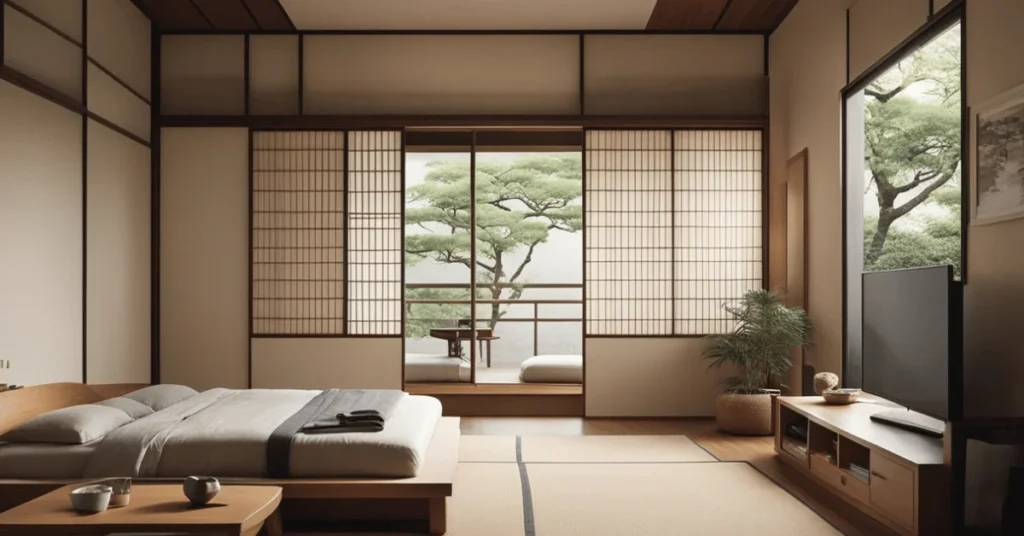
In a minimal Japanese bedroom, each element serves a purpose, fostering a clutter-free sanctuary. We focus on incorporation of efficient storage solutions, privacy options, and adaptable layouts alongside practical lighting to maintain this aesthetic.
Smart Storage Options
We embrace multifunctional furniture with built-in storage to minimize clutter. Beds with drawers, for instance, offer ample space for bedding and out-of-season clothing. A tall, slender wardrobe utilizes vertical space, allowing for more floor area. Traditional tansu chests are both decorative and functional, with their modular design making them suitable for various storage needs.
| Furniture Type | Functionality |
|---|---|
| Beds with drawers | Store clothes & bedding |
| Modular shelves | Display items & books |
| Tansu chests | Organize small items |
Privacy Solutions
In our bedrooms, privacy is paramount. We use fusuma and shoji screens, which are lightweight and can slide away when not needed, doubling as both door and artistic element with their delicate designs. Curtains offer a softer option and can be easily drawn. For a modern touch, frosted glass panels can provide privacy while allowing natural light to filter through.
Versatile Layouts
Our layouts are transformative, enabling the space to adapt to various needs throughout the day. By incorporating folding furniture, the room can easily transition from a restful bedroom to a serene living area or workspace. With everything having its place, the minimal Japanese bedroom remains orderly and spacious.
Practical Lighting Choices
We carefully select lighting that complements the serene atmosphere. A mix of ambient, task, and accent lighting allows for flexibility. Ceiling lights keep the space open, while wall-mounted lamps save on floor space. Natural lighting is maximized through the strategic placement of screens and curtains to foster a peaceful, illuminated setting.
| Lighting Type | Purpose |
|---|---|
| Ceiling light | Ambient illumination |
| Wall-mounted | Task-specific areas |
| Natural lighting | Enhances overall brightness |
Creating a Relaxing Atmosphere
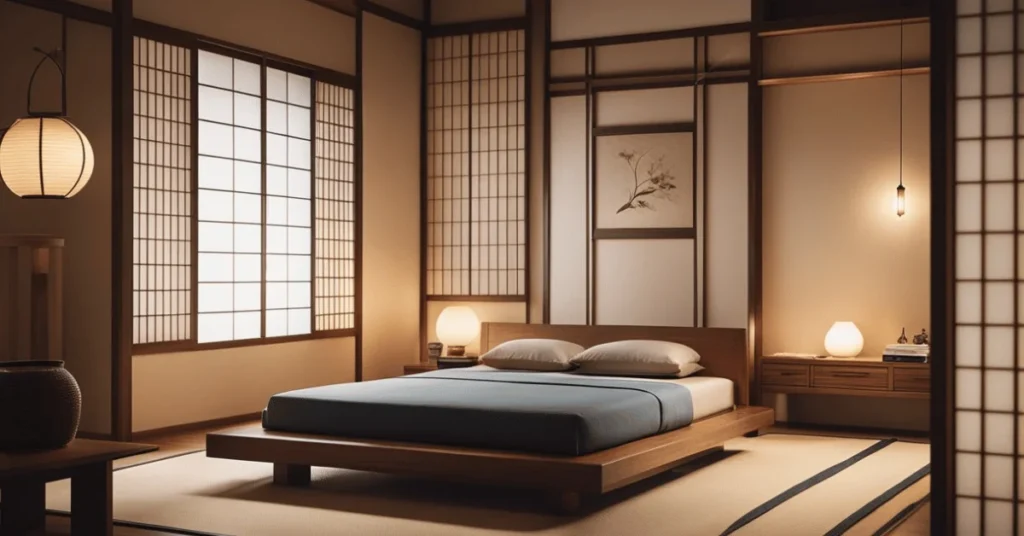
In minimal Japanese bedroom design, we focus on cultivating a tranquil haven through key elements like a connection to nature and a palette of soft, earthy colors. These aspects help establish harmony and peace, essential for relaxation.
Connection to Nature
We emphasize the inclusion of elements that signify the outdoors to create a soothing environment. Bringing in potted plants or a small bonsai can introduce a living element, while natural materials such as wood or bamboo add a tactile quality to the space. To further enhance the connection to nature, consider using tatami mats as flooring. They are not only traditional but also provide a unique earthy scent that contributes to the bedroom’s calm atmosphere.
Soft Color Schemes
We integrate natural and neutral colors to promote a restful state of mind. Shades of white, along with soft earthy tones such as beige, light brown, or muted greens, help maintain a visually serene setting. Avoiding bright colors is key, as they can be stimulating rather than calming. Instead, opting for a minimalistic color palette provides the subtle backdrop necessary for relaxation.
Zen Influences
The principles of Zen teach us to find peace and clarity. In our bedroom design, we carefully arrange furniture and decor to adhere to a balanced layout, promoting a sense of serenity. Keeping clutter to a minimum is crucial; choose simple and functional furniture. A low wooden bed or futon can be a central piece that aligns with Zen simplicity and invites tranquil slumber.
Guidelines for a Serene and Minimal Japanese Bedroom
We share a few essential tips to maintain a peaceful atmosphere:
- Minimize Clutter: Keep belongings neatly stored and out of sight. Use built-ins or under-bed storage to maintain a tidy appearance.
- Natural Light: Maximize natural light sources but provide options for soft lighting, such as rice paper lamps, for the evenings.
- Soft Textiles: Include soft bedding and cushions made from natural fabrics to enhance comfort and promote relaxation.
- Subtle Fragrance: A gentle fragrance, possibly from natural incense, can aid in creating a sense of calm.
Reflecting on these elements and incorporating them into a bedroom will foster a space that feels balanced and inherently peaceful, conducive to rest and tranquility.
Frequently Asked Questions
What principles should I follow to achieve a minimalist Japanese-style bedroom design?
We emphasize the principles of simplicity, natural elements, and functionality. Strive for a balance between empty spaces and furniture, ensuring every item has a purpose and contributes to a sense of calm.
How do you select furniture for a modern minimal Japanese bedroom?
We choose low-to-the-ground furniture with clean lines and natural materials. A platform bed and a simple bedside table often suffice, avoiding unnecessary ornamentation.
What color schemes are most commonly used in minimal Japanese bedroom decor?
We often utilize muted color palettes, such as soft whites, creams, and greys, accented with blacks or earth tones to maintain a serene and cohesive look.
Can you suggest some minimal Japanese bedroom decor ideas for a bedroom layout?
We recommend a Tatami mat flooring, Shoji screens for subtle privacy, and a selection of potted plants like bonsai or bamboo for a touch of nature.
What are the key characteristics of a minimal Japanese bedroom interior?
The key characteristics we incorporate are clean and straight lines, limited adornment, and the use of natural materials and textures to establish a tranquil and ordered space.
How can I incorporate Japandi elements into my minimal Japanese bedroom design?
On order to achieve a minimal Japanese bedroom , we blend Scandinavian functionality with Japanese rustic minimalism by selecting furniture that is both simple and practical, with a focus on craftsmanship and earthy tones.
We’ve explored the beauty of a minimal Japanese bedroom, but now we want to hear from you!
Do you have any personal tips or unique touches that enhance your minimalist bedroom? Share your thoughts and join the conversation in the comments below!

